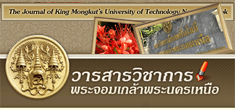Abstract
Rice husk and rice straw are waste materials generated largely in Thailand, as well as low value. However, these materials have the potentials to be used as raw materials for the production of binderless fiberboard. Therefore, this paper presents the effect of particle sizes and material types (rice husk and rice straw) on mechanical, physical and thermal properties of binderless fiberboard. The particle sizes used in experiment consist of 4 class interval; 1) smaller than 150 µm, 2) 150 to less than 212 µm, 3) 212 to less than 425 µm and 4) smaller than 425 µm. In manufacturing the sample fiberboard, the materials were pressed with a hot compression machine controlling temperature 220 oC and pressure 17.23 MPa for 25 min. According to the results, the particle sizes and material types significantly affected modulus of rupture (MOR), modulus of elasticity (MOE) and internal bond strength (IBS) of binderless fiberboard. The fiberboard produced with smaller particle sizes showed higher MOR, MOE, IBS and thermal conductivity, whereas percentage of water absorption and thickness swelling (TS) reduced. Likewise, the results also indicate that the fiberboard made from rice straw flour gave better MOR, MOE and thermal conductivity than the fiberboard from rice husk flour. Moreover, when compared to standard of fiberboard, the binderless fiberboard produced from rice husk flour or rice straw flour with size of smaller than 150 µm had MOR, MOE, IBS and TS passing requirements of Japanese Industrial Standard A 5905 in at least Type 5.
Keywords : Binderless fiberboard, Particle size, Natural fiber type, Statistical analysis, Hot compression




